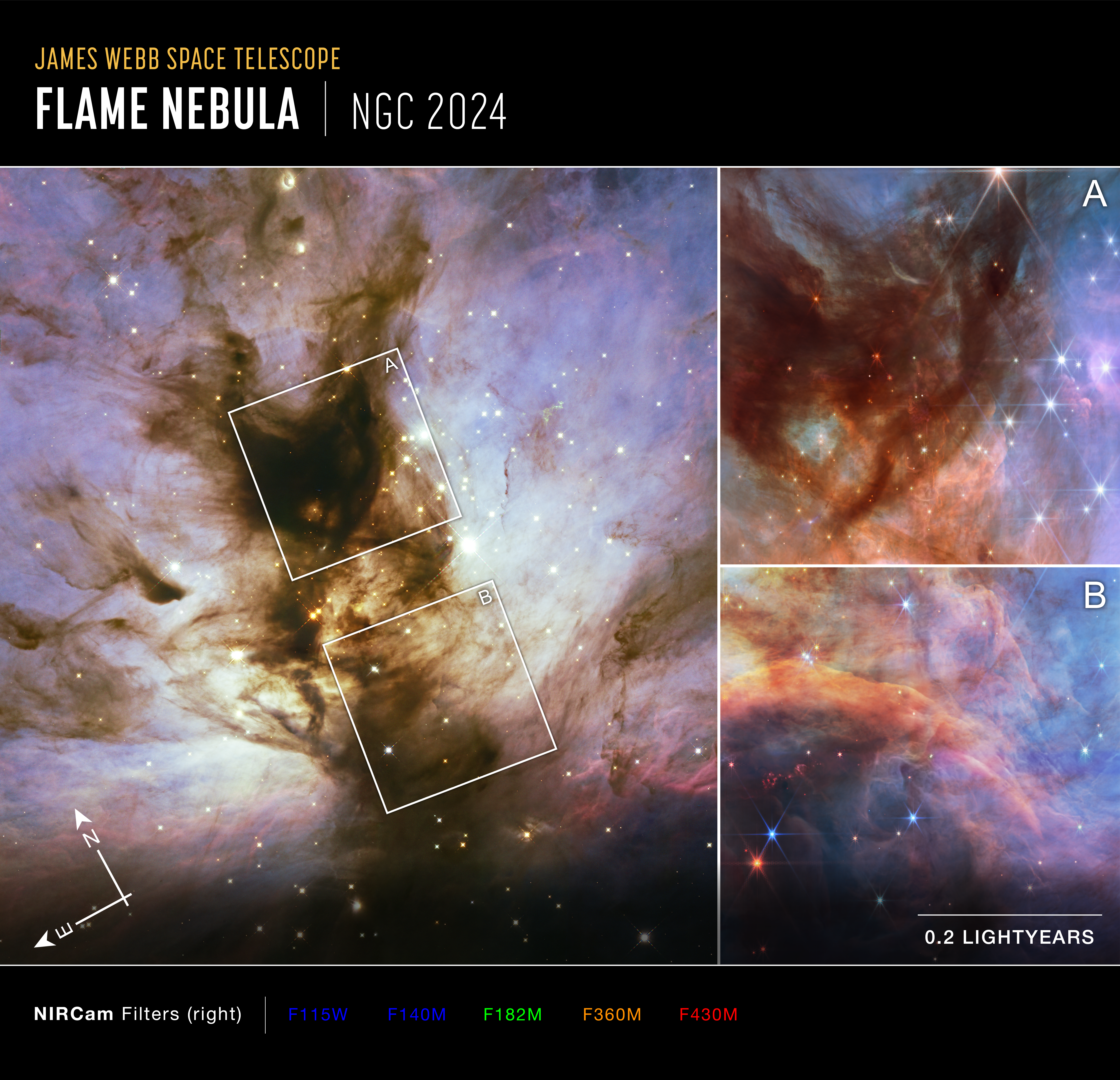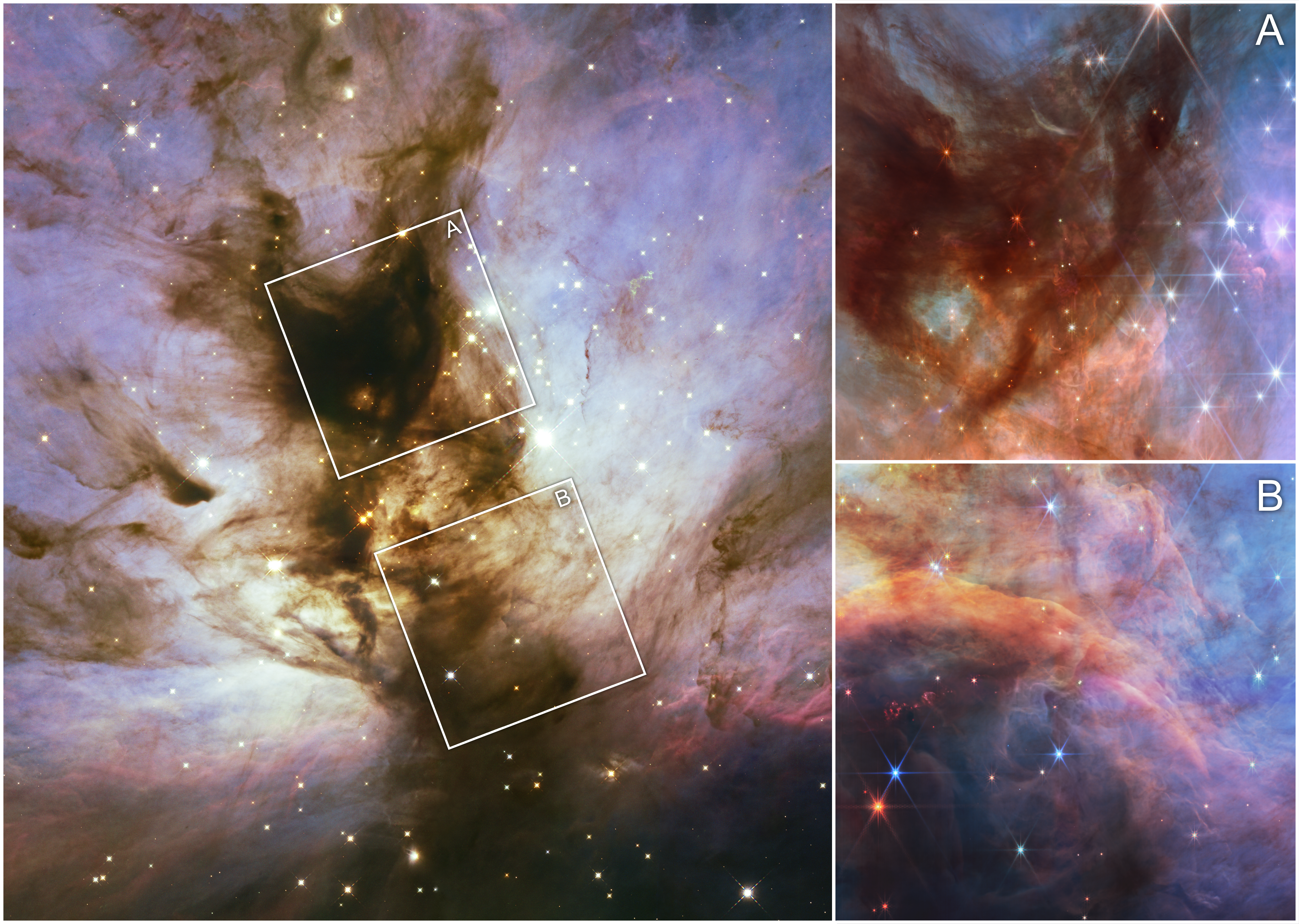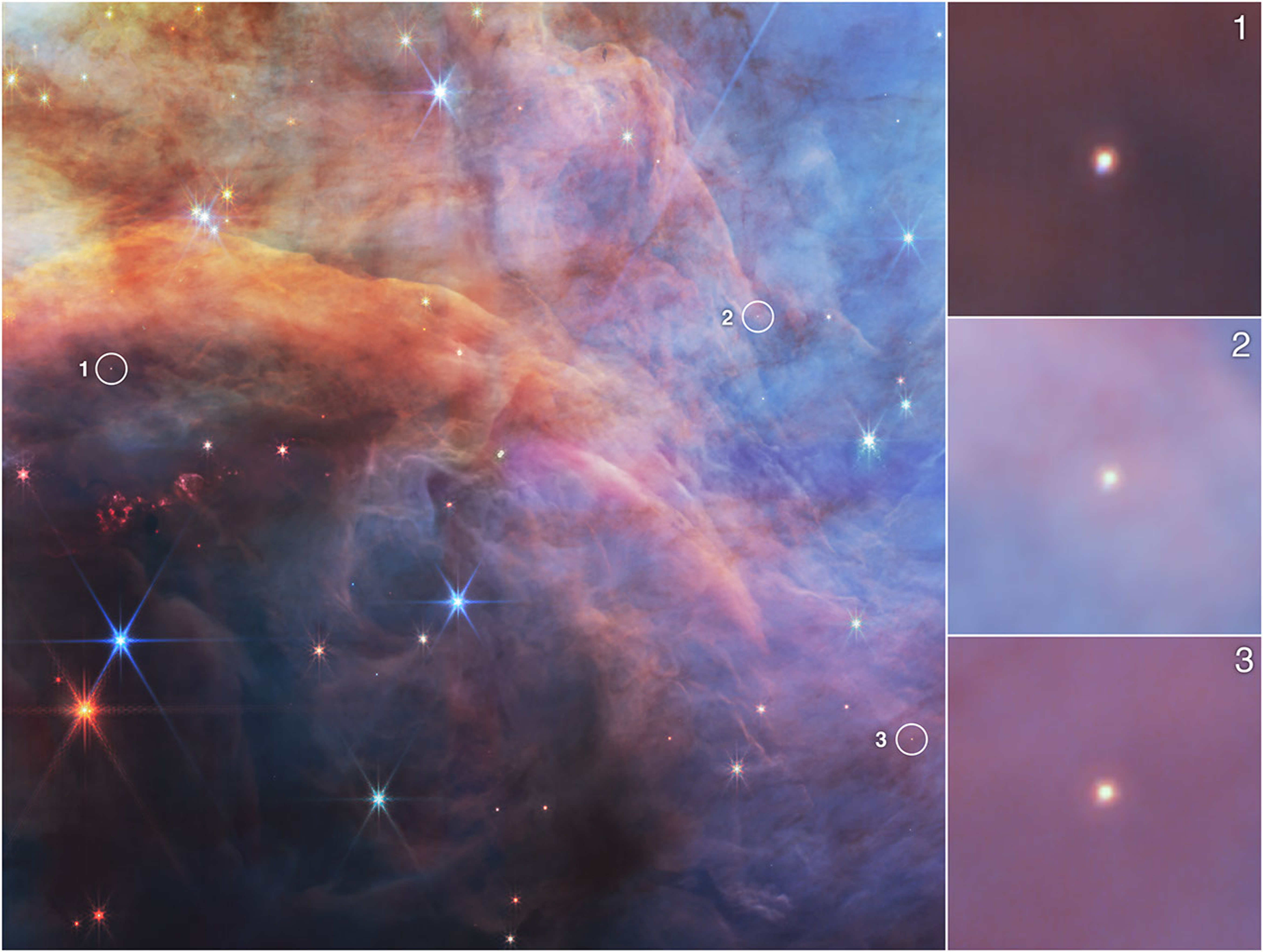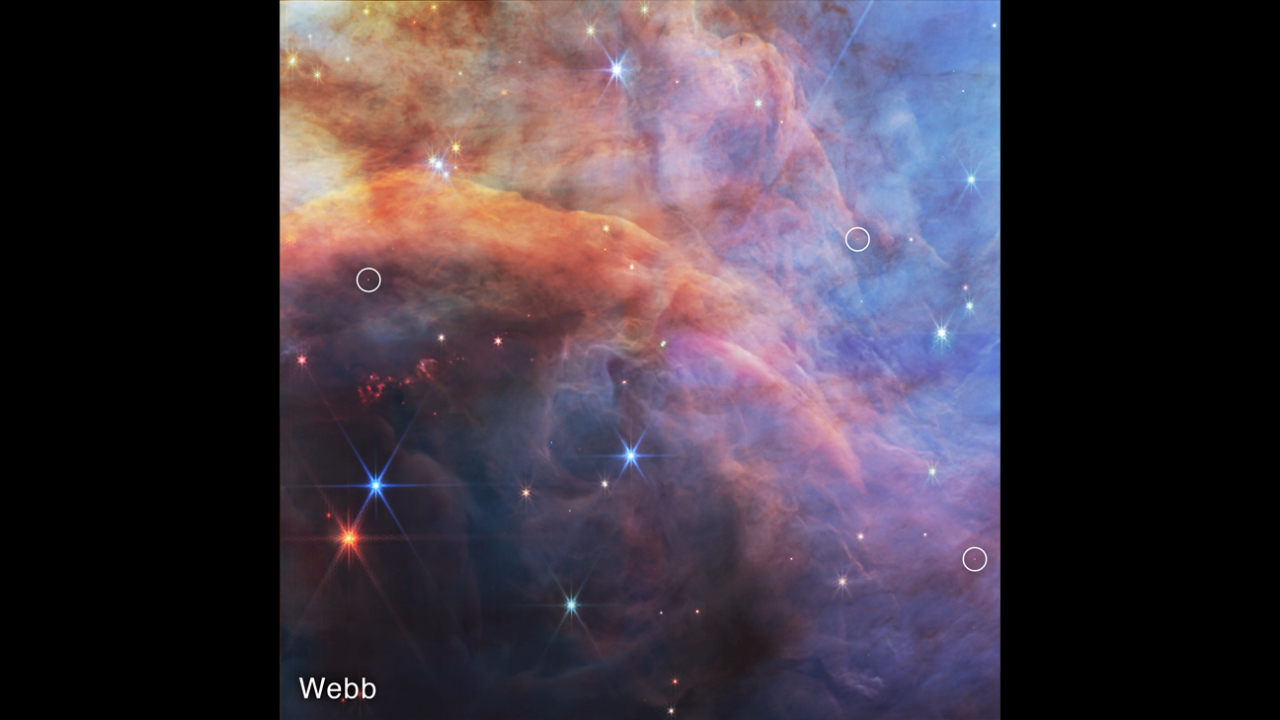1 min read
Flame Nebula: Hubble and Webb Observations (Compass Image)

Two images of the Flame Nebula (NGC 2024) at right, captured by Webb’s Near-Infrared Camera (NIRCam), with compass arrows, scale bar, and color key for reference. These images are magnified regions within the greater Flame Nebula, seen in the image at left captured by the Hubble Space Telescope.
The north and east compass arrows show the orientation of the image on the sky. Note that the relationship between north and east on the sky (as seen from below) is flipped relative to direction arrows on a map of the ground (as seen from above).
The scale bar is labeled in light-years, which is the distance that light travels in one Earth-year. (It takes 0.2 years, or about 2 and a half months, for light to travel a distance equal to the length of the bar.) One light-year is equal to about 5.88 trillion miles or 9.46 trillion kilometers. The field of view shown on the leftmost image is approximately 0.6 light-years across, and that of the rightmost image is approximately 0.4 light-years across.
The rightmost images show invisible near-infrared wavelengths of light that have been translated into visible-light colors. The color key shows which NIRCam filters were used when collecting the light. The color of each filter name is the visible light color used to represent the infrared light that passes through that filter.
Click here for a full description of the image.
Extended Description and Image Alt Text
Extended Description
Image titled “James Webb Space Telescope, Flame Nebula NGC 2024” with compass arrows, scale bar, and color key.
Image
A collage of three images showing a dusty nebula. The left two-thirds of the collage is taken up by an image of the nebula in visible light. The remaining third is taken up by two other images, one atop the other, in near-infrared. The visible light image has a pillar of dense brown dust running through the nebula at a diagonal from 5 o’clock to 11 o’clock. Wispy plumes appear to fly off from the pillar toward the sides amid blue clouds of the same material, which are whiter near the pillar. There are many white stars spread throughout. Two separate, white squares, tilted about 30 degrees, outline two areas in the pillar. The upper square has the letter “A” to the top right, while the lower square is marked by the letter “B”. These labels correspond to the two, magnified images of the nebula shown in near-infrared at right, with the top image also labeled “A” and the bottom image labeled “B”. Both images contain a mixture of reds, blues and browns, and show red, blue, and white stars.
Compass Arrows, Scale Bar, and Color Key
At the bottom left are compass arrows indicating the orientation of the image on the sky. The north arrow points in the 11 o’clock direction. The east arrow points toward 8 o’clock. At the lower right is a scale bar labeled 0.2 light-years. The length of the scale bar is about one-fifth the total width of the image. Below the image is a color key showing which NIRCam filters were used to create the image and which visible-light color is assigned to each filter. From left to right, NIRCam filters are: F115W and F140M are blue; F182M is green; F360M is orange; and F430M is red.
Image Alt Text
A collage of three images showing a dusty nebula. The left two-thirds of the collage is taken up by an image of the nebula in visible light, which shows a diagonal pillar of brown dust. Two separate, white squares outline two areas of the pillar. The remaining third is taken up by the other two images, one atop the other, magnifications of the boxed regions, in near-infrared. Both images contain a mixture of reds, blues and browns. At the bottom left are compass arrows indicating the orientation of the image on the sky. The north arrow points in the 11 o’clock direction. The east arrow points toward 8 o’clock. At the lower right is a scale bar labeled 0.2 light-years. The length of the scale bar is about one-fifth the total width of the image. Below the image is a color key showing which NIRCam filters were used to create the image and which visible-light color is assigned to each filter. From left to right, NIRCam filters are: F115W and F140M are blue; F182M is green; F360M is orange; and F430M is red.
About the Object
- R.A. PositionR.A. PositionRight ascension – analogous to longitude – is one component of an object's position.05:41:41.76
- Dec. PositionDec. PositionDeclination – analogous to latitude – is one component of an object's position.-01:54:33.30
- ConstellationConstellationOne of 88 recognized regions of the celestial sphere in which the object appears.Orion
- DistanceDistanceThe physical distance from Earth to the astronomical object. Distances within our solar system are usually measured in Astronomical Units (AU). Distances between stars are usually measured in light-years. Interstellar distances can also be measured in parsecs.About 1,400 light-years
- DimensionsDimensionsThe physical size of the object or the apparent angle it subtends on the sky.Hubble image is 7.2 arcmin across (about 3 light-years) Webb inset is 2 arcmin across (about 0.8 light-years)
About the Data
- Data DescriptionData DescriptionProposal: A description of the observations, their scientific justification, and the links to the data available in the science archive.
Science Team: The astronomers who planned the observations and analyzed the data. "PI" refers to the Principal Investigator. - InstrumentInstrumentThe science instrument used to produce the data.HST> WFC3/IR WEBB> NIRCam
- Exposure DatesExposure DatesThe date(s) that the telescope made its observations and the total exposure time.HST> 27 October 2018 - 24 April 2020 WEBB> 01 March 2023
- FiltersFiltersThe camera filters that were used in the science observations.HST> F105W, F130N, F139M WEBB> F115W, F140M, F182M, F360M, F430M
- Object NameObject NameA name or catalog number that astronomers use to identify an astronomical object.Flame Nebula, NGC 2024
- Object DescriptionObject DescriptionThe type of astronomical object.Star-forming region with LMO's
- Release DateMarch 10, 2025
- Science ReleaseNASA’s Webb Peers Deeper into Mysterious Flame Nebula
- CreditImage: NASA, ESA, CSA, STScI, Michael Meyer (University of Michigan), Matthew De Furio (UT Austin), Massimo Robberto (STScI), Alyssa Pagan (STScI)

These images are a composite of separate exposures acquired by the James Webb Space Telescope using the NIRCam instrument and the Hubble Space Telescope using the UVIS/IR instrument. Several filters were used to sample specific wavelength ranges. The color results from assigning different hues (colors) to each monochromatic (grayscale) image associated with an individual filter. In this case, the assigned colors are: Left (Hubble)> Blue= F105W, Green= F130N, Red= F139M Right (Webb)> Blue= F115W + F140M, Green= F182M, Orange= F360M, Red= F430M
Related Images & Videos

Flame Nebula: Hubble and Webb Observations
This collage of images from the Flame Nebula shows a near-infrared light view from NASA’s Hubble Space Telescope on the left, while the two insets at the right show the near-infrared view taken by NASA’s James Webb Space Telescope. Much of the dark, dense gas and dust, as well...

Low Mass Objects within the Flame Nebula (NIRCam Image)
This near-infrared image of a portion of the Flame Nebula from NASA’s James Webb Space Telescope highlights three low-mass objects, seen in the insets to the right. These objects, which are much colder than protostars, require the sensitivity of Webb’s instruments to detect...

Flame Nebula (Hubble and Webb Comparison)
This video alternates between a Hubble Space Telescope and a James Webb Space Telescope observation of the Flame Nebula, a nearby star-forming nebula less than 1 million years old. In this comparison, three low-mass objects are highlighted. In Hubble’s observation, the low-mass...
Share
Details
Laura Betz
NASA’s Goddard Space Flight Center
Greenbelt, Maryland
laura.e.betz@nasa.gov
NASA, ESA, CSA, STScI, Michael Meyer (University of Michigan), Matthew De Furio (UT Austin), Massimo Robberto (STScI), Alyssa Pagan (STScI)






























